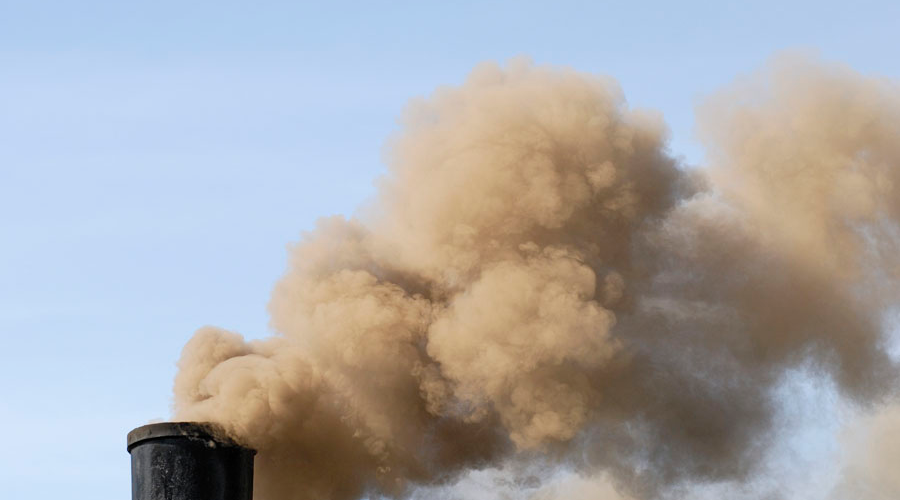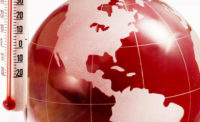American Lung Association: Climate change is making our air more unhealthy
Report comes as Trump administration weakens Clean Air Act enforcement

A new report from the American Lung Association (ALA) finds 133.9 million Americans at risk from air pollution – much of it ozone pollution that is worsening significantly due to warmer temperatures.
The ALA’s 2018 "State of the Air" report found that the four in ten Americans (41.4 percent) who live in counties with unhealthful levels of either ozone or particle pollution are at greater risk for premature death and other serious health effects such as lung cancer, asthma attacks, cardiovascular damage, and developmental and reproductive harm.
"Near record-setting heat from our changing climate has resulted in dangerous levels of ozone in many cities across the country, making ozone an urgent health threat for millions of Americans," said ALA National President and CEO Harold P. Wimmer. "The 'State of the Air' report should serve as a wake-up call for residents and representatives alike. Everyone deserves to breathe healthy air, and we must do more to protect the air we breathe by upholding and enforcing the Clean Air Act."
Trump EPA is rolling back enforcement
That warning comes amid a series of Trump administration memos which have weakened enforcement of Clean Air Act rules by allowing certain facilities to comply with less-stringent regulations and changing the way emissions are calculated.
Public health advocates and environmentalists have accused the administration of using memos to avoid seeking public input that regulatory changes would normally require.
ALA senior vice president for advocacy Paul Billings said the memos, “individually and taken together, will result in more air pollution and less enforcement of the Clean Air Act.”
Along with the enforcement changes, the ALA has identified other threats to the nation's air quality: changes to weaken the Clean Air Act itself, undercut the agency's reliance on health science to inform policy making, and roll back existing cleanup requirements for cars, trucks, oil and gas operations and power plants, including the Clean Power Plan to limit carbon pollution and address climate change.
"The Clean Air Act has saved lives and improved lung health for nearly 50 years," Wimmer said. "Congress and the EPA are tasked with protecting Americans—including protecting the right to breathe air that doesn't make people sick or die prematurely. We call on President Trump, EPA Administrator Scott Pruitt and members of Congress to fully fund, implement and enforce the Clean Air Act for all pollutants—including those that drive climate change and make it harder to achieve healthy air for all."
About the report
The "State of the Air" reports on the two most widespread outdoor air pollutants, ozone pollution and particle pollution. The report analyzes particle pollution in two ways: through average annual particle pollution levels and short-term spikes in particle pollution. Both ozone and particle pollution are dangerous to public health and can be lethal. But the trends reported in this year's report, which covers data collected by states, cities, counties, tribes and federal agencies in 2014-2016, reflect the ongoing challenges to reduce each pollutant in the changing political and outdoor climate.
A "sunburn on the lung"
Ozone Pollution
Inhaling ozone pollution is like getting a sunburn on the lung. It can trigger coughing and asthma attacks and may even shorten life. Warmer temperatures make ozone more likely to form and harder to clean up.
Compared to the previous year, the 2018 report finds that far more people suffered from unhealthy ozone pollution, with approximately 128.9 million people living in 185 counties that earned an F grade for ozone. Of the 10 most polluted cities, seven cities did worse, including Los Angeles and the New York City metro area.
Top 10 Most Ozone-Polluted Cities:
- Los Angeles-Long Beach, California
- Bakersfield, California
- Visalia-Porterville-Hanford, California
- Fresno-Madera, California
- Sacramento-Roseville, California
- San Diego-Carlsbad, California
- Modesto-Merced, California
- Phoenix-Mesa-Scottsdale, Arizona
- Redding-Red Bluff, California
- New York-Newark, New York–New Jersey-Connecticut-Pennsylvania
Particle Pollution
Unhealthy particles in the air emanate from wildfires, wood-burning devices, coal-fired power plants and diesel engines. Technically known as PM2.5, these microscopic particles lodge deep in the lungs and trigger asthma attacks, heart attacks and strokes, cause lung cancer and shorten life.
The 2018 report covers 2014-2016 data, the most recent data available, and includes the significant wildfires and resulting smoke that swept across the nation in 2016, but not those occurring in 2017. The report grades both daily spikes, called "short-term" particle pollution, and the annual average or "year-round" level that represents the concentration of particles day-in and day-out in each location.
The report finds that during 2014-2016, the year-round particle pollution levels continued to drop, maintaining a long-term trend, with a few notable exceptions, including Fairbanks, Alaska, where expanded monitoring newly identified the highest average levels in the nation. After spiking to record high levels in last year's report, days with high short-term particle levels also dropped in most locations.
Short-term Particle Pollution
In the 2018 "State of the Air" report, most cities experienced fewer days of spikes in particle pollution, yet 35.1 million people lived in the 53 counties with too many days when particle pollution peaked at unhealthy levels. Bakersfield, California remained the city with the greatest short-term particle pollution levels. Increased heat, changes in climate patterns, drought and wildfires—many related to climate change—contributed to the high number of days with unhealthy particulate matter.
Top 10 U.S. Cities Most Polluted by Short-Term Particle Pollution (24-hour PM2.5):
- Bakersfield, California
- Visalia-Porterville-Hanford, California
- Fresno-Madera, California
- Fairbanks, Alaska
- Modesto-Merced, California
- San Jose-San Francisco-Oakland, California
- Los Angeles-Long Beach, California
- Salt Lake City-Provo-Orem, Utah
- El Centro, California
- Pittsburgh-New Castle-Weirton, Pennsylvania-Ohio-West Virginia
Year-round Particle Pollution
The data available for the 2018 report show year-round particle pollution levels have dropped across much of the nation, some to their lowest levels yet. However, missing data from areas with invalid monitoring resulted in incomplete estimates of how many people nationwide are at risk from air pollution. According to EPA records, no complete data have been available for the entire state of Illinois since the 2014 report covering 2010-2012. In addition, the entire state of Mississippi and Los Angeles County and San Bernardino County in California lacked valid data for year-round particle pollution. The 2018 report, based on available but incomplete data, found that 9.8 million people lived in 16 counties where the annual average concentration of particle pollution was too high. But according to the Lung Association, as a result of the missing data, this likely vastly underestimates the people who are breathing unhealthy levels.
The importance of monitoring became particularly clear in the new ranking of Fairbanks, Alaska. Previously the metro area lacked sufficient monitoring data to provide year-round information. Now, improved monitoring, data revealed the dangerous levels of particle pollution year-round. In fact, Fairbanks is now the city with the highest year-round particle pollution in the 2018 report, up from number 17 in the 2017 report.
"The people of Fairbanks, Alaska, and all Americans have the right to know if the air they are breathing is dangerous. Improved monitoring is a critical step toward clean-up efforts that will save lives," Wimmer said. "Greater monitoring of air quality nationwide may also identify additional health risks in other locations in the United States."
Most cities continue to reduce their year-round particle pollution levels, some to their lowest levels yet. This continues a more than decade-long trend, as a result of steps taken under the Clean Air Act to reduce emissions. Despite these advancements, the 11 most polluted cities each violate the Clean Air Act's U.S. National Ambient Air Quality Standards designed to protect public health.
Top 11 U.S. Cities Most Polluted by Year-Round Particle Pollution (Annual PM2.5):
1. Fairbanks, Alaska
2. Visalia-Porterville-Hanford, California
3. Bakersfield, California
4. Los Angeles-Long Beach, California
5. Fresno-Madera, California
6. Modesto-Merced, California
7. El Centro, California
8. Pittsburgh-New Castle-Weirton, Pennsylvania-Ohio-West Virginia
8. Lancaster, Pennsylvania
10. San Jose-San Francisco-Oakland, California
10. Cleveland-Akron-Canton, Ohio
"More must be done to clean up the air so that everyone has healthy air to breathe," Wimmer said. "We need essential pollution monitoring information to safeguard the health of those most at risk of the effects of air pollution, including children, the elderly and those living with a lung disease."
Cleanest Cities
The "State of the Air" also recognizes the nation's cleanest cities, and again this year, only six cities qualified for that status. To rank as one of the nation's cleanest, each city must experience no high ozone or high particle pollution days and must rank among the 25 cities with the lowest year-round particle pollution levels during 2014-2016. Cities new to the list include Bellingham, Washington and Casper, Wyoming.
Cleanest U.S. Cities (listed in alphabetical order)
- Bellingham, Washington
- Burlington-South Burlington, Vermont
- Casper, Wyoming
- Honolulu, Hawaii
- Palm Bay-Melbourne-Titusville, Florida
- Wilmington, North Carolina
Learn more about the 2018 "State of the Air" report at Lung.org/sota.
Looking for a reprint of this article?
From high-res PDFs to custom plaques, order your copy today!








